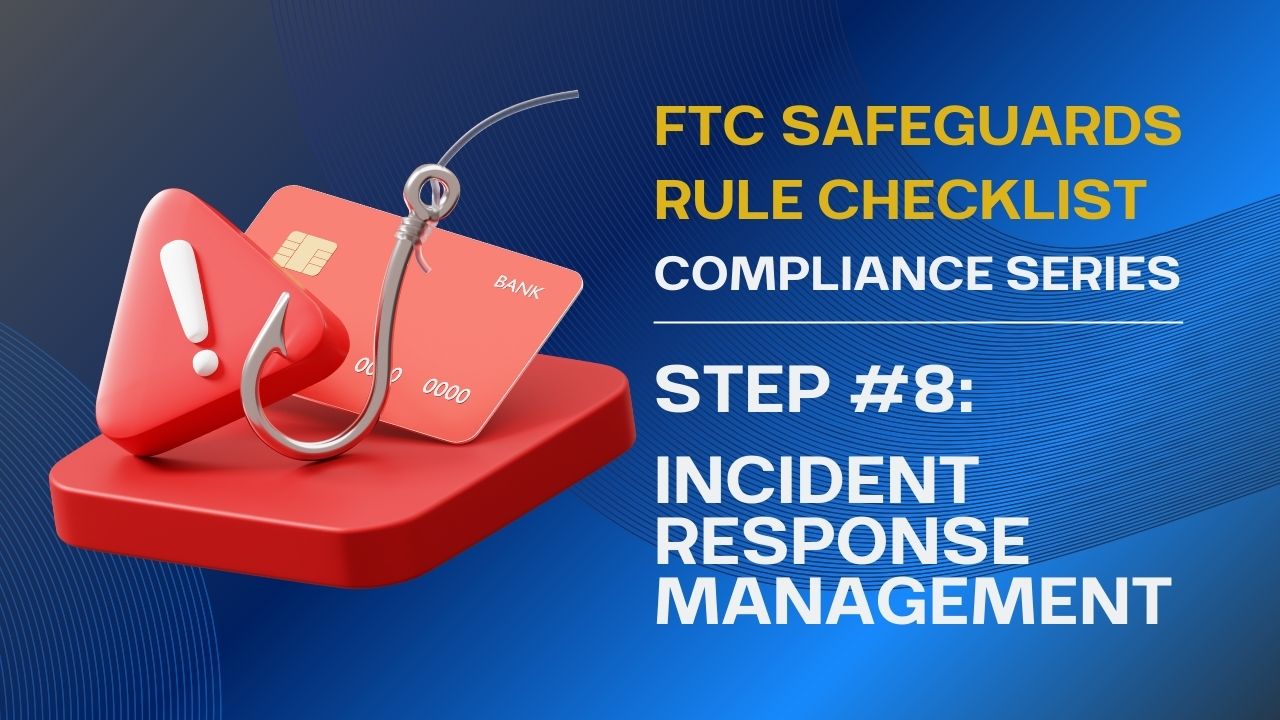FTC Safeguards Rule Checklist for Compliance Series: Mastering Incident Response
Apr 24, 2025
When it comes to cybersecurity, it’s not a matter of if something goes wrong—it’s when. That’s why this week in our FTC Safeguards Rule Compliance Checklist series, we’re diving into one of the most mission-critical components of your security program: the response and recovery plan. Section 314.4(h) of the Safeguards Rule isn’t just a regulatory checkbox—it’s your playbook for turning chaos into control when a security event strikes. Whether you’re building a response protocol from scratch or stress-testing the one you already have, we’re here to walk you through the essentials with clarity, confidence, and just enough dry humor to keep things readable. Let’s unpack what it really takes to stay compliant, stay prepared, and stay resilient.
Follow Along with the FTC Safeguards Rule Compliance Checklist
Welcome back to our FTC Safeguards Rule series—your pitstop for practical guidance and caffeine-fueled compliance strategies. Whether you’re launching a new security program or prepping for an audit with sweaty palms and too many browser tabs open, our digestible checkpoints are here to keep you sharp and secure.
The updated regulations provide concrete guidance on implementing security measures and developing information security plans, making it easier for organizations to understand their compliance obligations in light of evolving technology and threats.
For the visual thinkers in the room (you know who you are), we’ve put together a companion FTC Safeguards Rule Checklist Infographic. It’s designed as your digital co-pilot—intuitive, digestible, and slightly less judgy than that spreadsheet you keep ignoring.

👉 Download the FTC Safeguards Rule Checklist For Compliance Infographic
What Is the FTC Safeguards Rule?
Rewind to 2003—when cybersecurity was more of a buzzword than a budget line. That’s when the FTC Safeguards Rule made its debut under the Gramm-Leach-Bliley Act (GLBA), with a noble goal: protect consumers’ financial data from unauthorized access, misuse, and breach.
Fast forward to today, where one phishing email can spiral into a six-figure data compromise, and the Rule got a much-needed 2021 facelift. Now, it lays out crystal-clear expectations for what a “reasonably designed” cybersecurity program looks like—including specific, enforceable requirements. The federal trade commission's updated rule emphasizes safeguarding customer information by requiring businesses to implement measures to secure customer data. In short, if you’re customer sensitive information like Nonpublic Personal Information (NPI), you’re responsible. The revised rule provides more concrete guidance to ensure compliance with data security regulations.
Who Must Comply?
If your business is even adjacent to financial services, chances are you’re considered a “financial institution” under the Rule, which encompasses a range of activities that are financial in nature or incidental to such financial activities. Here’s a snapshot of who’s in the club (no velvet rope required):
-
Tax prep and accounting firms
-
Auto dealerships with financing options
-
Mortgage brokers
-
Credit repair services
-
Non-SEC registered investment advisors
-
Payday lenders
-
Property appraisers
Basically, if you collect or process financial data—your compliance journey starts here. Adhering to these regulations is crucial for operating as a legitimate business, ensuring both legal compliance and customer trust.
FTC Safeguards Rule: Key Requirements
To stay on the FTC’s nice list, your cybersecurity program should address all the following:
-
Appoint a qualified security individual (§ 314.4(a))
-
Develop a risk-based security strategy (§ 314.4(b))
-
Implement safeguards based on identified risks (§ 314.4(c))
-
Regularly test and monitor controls (§ 314.4(d))
-
Train your employees on security awareness (§ 314.4(e))
-
Manage third-party service providers securely (§ 314.4(f))
-
Continuously evolve your program (§ 314.4(g))
-
Establish an incident response plan (§ 314.4(h)) ← This Week’s Focus
-
Notify customers and regulators in case of breach
-
Report to your board of directors (§ 314.4(i))
The safeguards rule requires covered financial institutions to develop and maintain a comprehensive information security program. This includes written procedures, risk assessments, the implementation of appropriate technical and physical safeguards, and breach notification protocols.
A written information security plan is essential to demonstrate how your organization protects customer data. This plan must be tailored to your specific needs and risks, addressing various safeguards while ensuring compliance with updated regulatory requirements.
🔦 Spotlight: § 314.4(h) – Building an Incident Response Plan and Information Security Program That Actually Works

When a security incident hits, it doesn’t knock politely—it crashes through the front door. That’s why the FTC requires not just any response plan, but a comprehensive, written, and thoroughly tested incident response plan. This plan should serve as both a playbook and a protective shield, helping you respond to and recover from cyberattacks that could otherwise compromise customer trust and legal standing. Additionally, it is crucial to monitor and test the effectiveness of your safeguards against actual and attempted attacks to ensure your response plan remains robust.
The Rule outlines seven key areas your plan must address. Let’s take them one by one—with practical commentary and Input Output’s compliance-minded lens.
Security awareness training is another critical component of your incident response plan. Ongoing training equips employees with the knowledge to recognize and respond to threats, thereby reinforcing the overall effectiveness of the security measures in place.
🎯 1. Set Clear Goals (§ 314.4(h)(1))
Your response plan needs a purpose beyond “fix it fast.” At its core, the plan should aim to contain damage, restore normal operations, comply with legal obligations, and mitigate financial and reputational fallout. These goals should be specific, actionable, and reviewed regularly to reflect the evolving risk landscape.
Additionally, addressing security risks is crucial. Developing comprehensive information security programs can help identify and mitigate potential threats, ensuring customer information remains protected.
For instance, goals might include reducing incident response time by 30%, minimizing data loss, or ensuring compliance with 72-hour breach notification windows. The clearer and more measurable the goals, the easier it becomes to align your processes, people, and tech.
Bullet Recap:
-
Minimize operational disruption
-
Limit financial and reputational damage
-
Ensure fast, informed decision-making
-
Comply with breach notification laws
🧰 2. Document Internal Response Processes (§ 314.4(h)(2))

Think of this as the choreography for your cyber crisis ballet. Your plan should document who does what, when, and how—across every stage of the incident lifecycle. This includes initial detection (from automated alerts or end-user reports), triage, containment, eradication, recovery, and post-incident review. Effective information systems are crucial here, as it structures the electronic resources needed for handling customer information, ensuring it is accessed, maintained, and protected properly, and links to security events and compliance measures.
Vague processes leave room for delays and finger-pointing. Instead, develop detailed workflows that include timelines, escalation triggers, and cross-functional coordination procedures. Having these documented and rehearsed ensures that even under pressure, your response remains coordinated and effective.
Bullet Recap:
-
Detection protocols (SIEM alerts, IDS/IPS monitoring)
-
Initial triage and threat categorization
-
Escalation procedures
-
Chain-of-command flowcharts (yes, make it a chart)
👥 3. Clarify Roles and Decision Authority (§ 314.4(h)(3))
During a breach, the last thing you want is a team full of people asking, “Am I supposed to handle this?” Your plan must define roles and responsibilities with zero ambiguity. Everyone should know their job, from the incident commander to the communications lead, and from IT forensics to HR. It is crucial to have a senior officer responsible for overseeing compliance and reporting on the program's status, ensuring accountability.
Decision-making authority should also be tiered based on severity. A minor phishing incident doesn’t need board-level involvement, but a ransomware attack might. Formalize these levels so decisions happen swiftly and within the right hands.
Bullet Recap:
-
Who leads the response (usually your CISO or another Qualified Individual)
-
Who talks to customers, regulators, and the press
-
Who manages containment, remediation, and documentation
🔄 4. Plan for Internal & External Communication (§ 314.4(h)(4))

Communication during an incident can be the difference between transparency and turmoil. Internally, stakeholders—from the C-suite to help desk staff—must be informed promptly, consistently, and with just the right level of detail. Externally, regulators, customers, and vendors need factual, timely updates—not half-baked panic statements.
It is crucial to restrict access to sensitive information and encryption keys to only authorized users to prevent security breaches. Implement safeguards to authenticate authorized users and monitor their activities to safeguard sensitive data and minimize risks associated with unauthorized access.
Plan out your communication templates in advance. Build an inventory of notification scripts, press statements, FAQs, and escalation paths to legal counsel and PR. Also, ensure that your incident response communications plan aligns with breach notification laws across jurisdictions you operate in.
Bullet Recap:
-
When and how to notify affected individuals
-
Legal obligations for breach notifications (state and federal)
-
Coordination with third-party vendors
-
Press and stakeholder messaging
🛠️ 5. Remediate System Weaknesses (§ 314.4(h)(5))
Once the fire is out, don’t just sweep up the ashes—find out how the fire started. Remediation should be baked into your incident response plan, detailing how your team identifies root causes, applies fixes, and validates that those fixes worked.
This step often reveals deeper security or architectural weaknesses: outdated software, missing patches, overly permissive access controls, or even human error from poor training. Changes in software, vendor relationships, access policies, or personnel can potentially undermine existing security measures. A solid plan includes a post-incident patch and configuration management protocol to ensure vulnerabilities are resolved, not just documented.
Bullet Recap:
-
Root cause analysis
-
Patch management and vulnerability remediation
-
Documentation of what went wrong and why
-
Post-mortem debriefs with your security team
🧾 6. Keep Detailed Documentation (§ 314.4(h)(6))

If it’s not documented, it didn’t happen—as far as regulators are concerned. You need thorough logs and records of every action taken during and after a security incident. This includes initial reports, emails, alerts, incident timelines, remediation efforts, and lessons learned.
This documentation isn’t just for internal audits—it’s also critical in case of FTC inquiries, legal challenges, or insurance claims. Build a response log template and keep everything centralized, timestamped, and securely stored.
Bullet Recap:
-
Timeline of events
-
Actions taken and by whom
-
Evidence of compliance steps (alerts, logs, communications)
🔁 7. Review, Revise, Repeat (§ 314.4(h)(7))
Your incident response plan should evolve—because threats evolve. The final FTC requirement is about adaptability: regularly reviewing your plan, refining it, and incorporating lessons learned. Conduct quarterly tabletop exercises to simulate attacks and stress-test your response mechanisms.
Incorporate continuous monitoring to enhance your information security program by regularly testing safeguards and procedures. This continual oversight is vital to detect potential threats and ensure that security measures are effective.
Make sure these revisions aren’t just performative. Document changes, communicate them across teams, and update training materials. Incident response is a muscle—the more you flex it, the stronger and smarter it gets.
Bullet Recap:
-
Test your plan with tabletop exercises
-
Update procedures based on new threats
-
Refine roles and escalation paths
Data Breach Response and Notification

When it comes to data breaches, the FTC Safeguards Rule is clear: covered financial institutions must have a written incident response plan. This plan is your blueprint for promptly responding to and recovering from any security event that results in unauthorized access to or misuse of customer information.
Your incident response plan should include procedures for internal reporting, risk assessments, risk management and control decisions, service provider arrangements, results of testing, security events or violations and responses to them, and recommendations for changes to the information security program.
In the event of a data breach, you must notify the Federal Trade Commission (FTC) as soon as possible, and no later than 30 days after discovering a “notification event.” A notification event is defined as a security breach involving the unauthorized acquisition of at least 500 consumers’ unencrypted information.
Use the FTC’s online reporting form to provide details about the breach, including the number of affected consumers and the type of information compromised. Your incident response plan should also include procedures for containment, eradication, recovery, and post-incident activities.
Regular testing of your incident response plan is crucial to ensure its effectiveness. Update the plan as necessary to address new risks and emerging threats. In the event of a data breach, you must also provide notice to affected consumers and the FTC, as required by the FTC Safeguards Rule and other applicable laws and regulations.
By having a robust incident response plan in place, you can limit damage, protect your customers, and demonstrate to regulators that you take information security seriously.
🤝 How Input Output Can Support Your Security Evolution
Staying compliant while managing everyday operations can feel like you’re debugging a jet engine mid-flight. Ensuring your company's compliance with the Safeguards Rule is crucial. That’s where Input Output steps in—not just as a vendor, but as a strategic compliance ally.
We help you not only meet the rigorous demands of FTC § 314.4(h) but also enhance your organization's security posture. By conducting thorough gap analyses and improving your information security policies, we future-proof your entire security program.
📄 Strategic Policy & Control Templates
We provide field-tested templates for security policies, third-party risk, and access governance—pre-aligned with FTC expectations. From legal-ready data protection clauses to access control matrices, our docs help you tighten processes without starting from scratch.
🔍 Risk & Security Program Assessments
We don’t just point out gaps—we map them to specific regulatory requirements. Our assessments reveal where your controls fall short, prioritize fixes, and give you a clean narrative for your board or regulator. Conducting regular vulnerability assessments is a crucial part of this process, ensuring that system-wide scans are performed every six months and whenever there are material changes or potential threats. This proactive approach helps maintain robust cybersecurity measures.
📊 Oversight, Audits & Accountability
Worried about the next audit? Don’t be. We offer frameworks and toolkits for internal reviews, vendor evaluations, and board-level reporting—making oversight easier, not harder.
Additionally, we emphasize the importance of periodic penetration testing as a key element of an effective information security plan under the Safeguards Rule.
🎓 Team Training & Testing
Our awareness training and simulated attack platforms help your employees spot scams before they spread. We track engagement, generate reports, and even test response times—so you’re never flying blind.
✅ Full-Service WISP Development

Whether you’re building from zero or refining a legacy document, we’ll help construct a robust Written Information Security Program that aligns with every letter of FTC § 314.4. Our approach ensures that your company's information security program includes critical elements such as safeguards, staff training, monitoring of service providers, and the importance of keeping the program current against evolving threats.
Need a partner that turns compliance chaos into streamlined confidence? Let’s talk. With Input Output by your side, you won’t just keep up—you’ll stay ahead.
Wrapping It Up: Planning for the Unplanned
A written incident response plan isn’t just a compliance checkbox—it’s your lifeline in a breach. Done right, it limits damage, protects your customers, and shows regulators you mean business by incorporating physical safeguards. Done wrong… well, you’ll read about it on LinkedIn.
Make sure your plan is comprehensive, practical, and regularly tested to protect customer information. Trust us: future-you will thank you.
STAY INFORMED
Subscribe now to receive the latest expert insights on cybersecurity, compliance, and business management delivered straight to your inbox.
We hate SPAM. We will never sell your information, for any reason.


